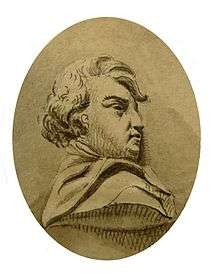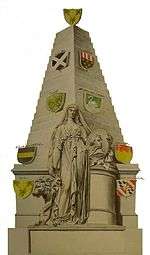Joan Gideon Loten
| Joan Gideon Loten | |
|---|---|
 | |
| 29th Governor of Zeylan | |
|
In office 10 September 1752 – 17 March 1757 | |
| Preceded by |
Jacob de Jong as acting governor |
| Succeeded by | Jan Schreuder |
| Personal details | |
| Born | 16 May 1710 |
| Died | February 25, 1789 (aged 78) |
Joan Gideon Loten (also spelt Johan or John) (16 May 1710 – 25 February 1789) was a Dutch servant in the colonies of the Dutch East India Company (VOC), the 29th Governor of Zeylan, Fellow of the Royal Society (elected 1760) and Fellow of the Society of Antiquaries of London (elected 1761). During his time in the colonies he made collections of natural history. In 1758 he moved to Holland. Nine months after his return from the Dutch East Indies he moved to London, where he lived for 22 years and interacted with scholarly societies and shared his natural history illustrations and collections.
Career
Early years
Joan Gideon Loten, born in Groenekan, near Utrecht he was the eldest son of secretary of the waterboard Joan Carel Loten (1669 - 1769) and Arnoldina Maria van Aerssen van Juchen (1685 - 1775). The Loten family originally came from the Southern Netherlands. Circa 1720 Loten lived with his parents and younger brother Arnout (1719-1801) in Utrecht. In 1726 he was a student of the Utrecht University. One of his teachers was Pieter van Musschenbroek. In March 1728 he left University and became a clerk of the Amsterdam Chamber of the Dutch East India Company. By means of patronage of members of his family Loten was appointed junior merchant of the Company in 1731.
Servant in the Dutch East Indies
In January 1732 he left the Dutch Republic with the East India man Beekvliet and headed to Batavia (Jakarta). On 25 August 1733 he married Anna Henriette van Beaumont (1716-1755), a member of a prominent family in Batavia (for example, her uncle Isaak Augustijn Rumpf had been Governor of Dutch Ceylon from 1716 to 1723). Eleven years later he was elected Governor of Makassar (Ujung Pandang) (1744-1750) and in 1752 he became himself Governor of Ceylon (1752-1757). In 1749 he was elected Councillor of the Dutch East Indies and thus obtained a seat in the government of the Dutch East India Company at Batavia. He was a capable administrator. He was usually respectful of the native population and did not exercise immoderate forms of supremacy. There is nothing to indicate that he pursued personal wealth by means considered improper or ruthless by his contemporaries. Although he was successful in the Dutch East Indies, in later years he became embittered against the Company and the way the Court of directors in Amsterdam and the Government at Batavia treated its former servants.
Back to Europe
In 1758 Loten repatriated as Admiral of the Return Fleet in the Dutch Republic. He returned to his homeland with an estimated fortune of about 700,000 Dutch guilders. Part of this East Indian fortune came from private trading and emoluments resulting from his offices.The majority of his Indian capital came from the legacy of Nathanael Steinmetz, a former governor and director of Amboyna. The capital afforded Loten financial independence during the rest of his life. Once he returned to the Dutch Republic, he felt like an outsider, excluded from the circles of the aristocratic and patrician class and estranged from his orthodox and narrow-minded Utrecht Calvinistic relatives. This led him to travel to England scarcely nine months after his return from the East Indies. Loten lived in London with several interruptions for twenty two years. The city’s amusements and cosmopolitan intellectual atmosphere gave him a feeling of freedom.
Although his early efforts to integrate into English society suggest an inclination towards the British way of life, Loten ultimately remained a Dutchman in his tastes and sympathies. This became increasingly prominent during his stay in England. In the 1770s, his feelings towards his British acquaintances, and towards British society in general, changed. After the outbreak of the Fourth Anglo-Dutch War in 1780.In November 1781 he returned to Utrecht.

February 25, 1789 Loten died in his house Cour de Loo at the Utrecht Drift. He was buried in the Utrechts Jacobikerk. In the London Westminster Abbey an impressive monument, made by Thomas Banks, was erected in his memory in 1795 (see illustration).
Loten’s contribution to natural history
Loten was well versed in the zoological, astronomical, genealogical and medical literature of his era. Loten’s activities as a collector were those of a virtuoso in the sense that his interest in natural phenomena was based purely upon a fascination with exotic nature and its unique and rare components. In Engeland he came in touch with naturalists in the just founded British Museum. He donated watercolours, stuffed birds and mineral stones to the British Museum. Joseph Banks was in Londen Loten’s neighbour. Joseph Banks, the later President of the Royal Society, accompanied Captain James Cook as a private naturalist on the HMS Endeavour (1768-1771). Thanks to Banks, the gentleman naturalist Thomas Pennant and ‘the father of British ornithology’ George Edwards, Loten’s natural history collection was copied and described in several 18th-century English natural history books.
At present the Loten collection is preserved in the London Natural History Museum, British Library, Teylers Museum in Haarlem, Rijksprentenkabinet in Amsterdam and Nationaal Archief in The Hague. Documents concerning his colonial career are in the national archive in the Hague. Personal memoirs and letters are dispersed over various collections in England and the Netherlands.
See also
Sources
- A.J.P.Raat: The life of Governor Joan Gideon Loten (1710-1789). Hilversum, Uitgeverij Verloren, 2010. ISBN 978-90-8704-151-9
External links
| Government offices | ||
|---|---|---|
| Preceded by Jacob de Jong as acting governor |
Governor of Zeylan 1757-1762 |
Succeeded by Jan Schreuder |